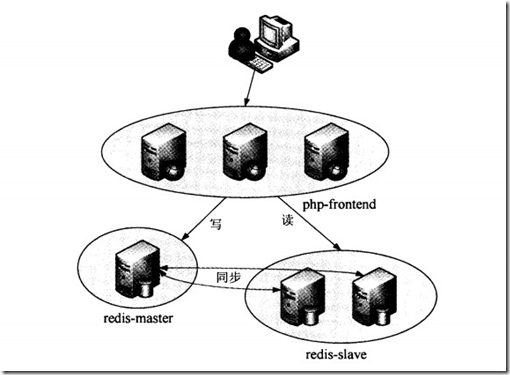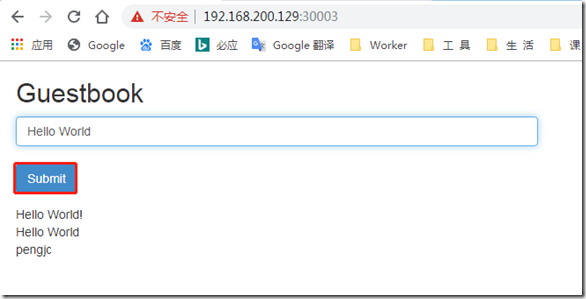Base environment
System version: CentOS Linux release 7.5.1804 (Core)
Kubernetes version: kubernetes 1.3
Project Background
Guestbook message board system will be built through Pod, RC, Service and other resource objects, and a "Hello World" message will be displayed in the web page after successful launch.Its system architecture is a distributed web application based on PHP+Redis. Front-end PHP Web sites complete query and add functions of user messages by accessing the back-end Redis.Redis is also deployed in Master+Slave mode, enabling read-write separation of data.
Project Architecture
The Web tier is an Apache service based on PHP pages, which starts up three instances to form a cluster to balance the load of visiting websites.Redis Master starts one instance for writing (adding a message) and Redis Slave starts two instances for reading (reading a message).Data synchronization between Redis Master and Slave is accomplished by the data synchronization mechanism that Redis has.
Service Deployment
1. Redis Master deployment
1.1 Create redis-master RC
You can define a service, then define an RC to create and control the associated Pod, or define an RC to create a Pod, then define the associated Service.
First, create a RC definition file named redis-master, redis-master-controller.yaml, for redis-master.
# cat redis-master-controller.yaml apiVersion: v1 kind: ReplicationController #Indicates that this is an RC metadata: name: redis-master labels: name: redis-master spec: replicas: 1 selector: name: redis-master template: metadata: labels: name: redis-master spec: containers: - name: master image: kubeguide/redis-master ports: - containerPort: 6379
Once created, publish to the cluster on the master node
# kubectl create -f redis-master-controller.yaml replicationcontroller/redis-master created
Confirm success of RC and OD creation with kubectl get command
# kubectl get rc NAME DESIRED CURRENT READY AGE redis-master 1 1 0 70s # kubectl get pods -o wide| grep redis redis-master-j58mw 1/1 Running 0 3m59s 172.17.39.7 192.168.200.130 <none> <none>
1.2 Create redis-master service
After redis-master Pod has been created and is functioning properly, create the Service associated with it
# cat redis-master-service.yaml apiVersion: v1 kind: Service metadata: name: redis-master labels: name: redis-master spec: ports: - port: 6379 targetPort: 6379 selector: name: redis-master
Run the kubectl create command to create the service
# kubectl create -f redis-master-service.yaml service/redis-master created # kubectl get services | grep redis-master redis-master ClusterIP 10.0.0.116 <none> 6379/TCP 40s
2. Redis slave deployment
This example starts two copies of the redis-slave service, where the Redis process synchronizes with the redis-master to form a Redis cluster with read-write separation capabilities.The PHP page of the message board reads the message data by accessing the redis-slave service.
2.1. Create redis-slave RC
# cat redis-slave-controller.yaml apiVersion: v1 kind: ReplicationController metadata: name: redis-slave labels: name: redis-slave spec: replicas: 2 selector: name: redis-slave template: metadata: labels: name: redis-slave spec: containers: - name: slave image: kubeguide/guestbook-redis-slave env: - name: GET_HOSTS_FROM value: env ports: - containerPort: 6379
In the configuration section of the container, an environment variable GET_HOSTS_FROM=env is set, which means to get the IP address information of the redis-master service from the environment variable.
The startup script/run.sh in the redis-slave image is:
# kubectl create -f redis-slave-controller.yaml replicationcontroller/redis-slave created # kubectl get rc | grep redis redis-master 1 1 1 45m redis-slave 2 2 2 103s # kubectl get pod | grep redis redis-master-j58mw 1/1 Running 0 45m redis-slave-c42bx 1/1 Running 0 2m3s redis-slave-s74b8 1/1 Running 0 2m3s
2.2 Create redis-slave service
Create a Service related to redis-slave, similar to the redis-master Service.
# cat redis-slave-service.yaml apiVersion: v1 kind: Service metadata: name: redis-slave labels: name: redis-slave spec: ports: - port: 6379 targetPort: 6379 selector: name: redis-slave
Run kubectl to create a Service
# kubectl create -f redis-slave-service.yaml service/redis-slave created # kubectl get svc | grep redis redis-master ClusterIP 10.0.0.116 <none> 6379/TCP 39m redis-slave ClusterIP 10.0.0.173 <none> 6379/TCP 49s
3. Deploy frontend
3.1 Create deployment frontend rc
# cat frontend-controller.yaml
apiVersion: v1
kind: ReplicationController
metadata:
name: frontend
labels:
name: frontend
spec:
replicas: 3
selector:
name: frontend
template:
metadata:
labels:
name: frontend
spec:
containers:
- name: frontend
image: kubeguide/guestbook-php-frontend
env:
- name: GET_HOSTS_FROM
value: env
ports:
- containerPort: 80
In the configuration section of the container, an environment variable GET_HOSTS_FROM=env is set, which means to get the IP address information of the redis-master and redis-slave services from the environment variable.
# kubectl create -f frontend-controller.yaml replicationcontroller/frontend created
View created
# kubectl get rc NAME DESIRED CURRENT READY AGE frontend 3 3 3 5m1s redis-master 1 1 1 67m redis-slave 2 2 2 24m # kubectl get pods NAME READY STATUS RESTARTS AGE frontend-mnd85 1/1 Running 0 5m43s frontend-pmpdb 1/1 Running 0 5m43s frontend-zd2n5 1/1 Running 0 5m43s
3.2 Create deployment frontend service
Finally, a frontend Service is created, mainly to map a port accessible by an external network to a Service in the Kuberbetes cluster using NodePort, the Service's purpose, so that the external network can access the services in the cluster through NodeIP+NodePort.
# cat frontend-service.yaml
apiVersion: v1
kind: Service
metadata:
name: frontend
labels:
name: frontend
spec:
type: NodePort
ports:
- port: 80
nodePort: 30003
selector:
name: frontend
Run the kubectl create command to publish to the cluster
# kubectl create -f frontend-service.yaml service/frontend created # kubectl get svc NAME TYPE CLUSTER-IP EXTERNAL-IP PORT(S) AGE frontend NodePort 10.0.0.145 <none> 80:30003/TCP 24s
web Page Browsing
http://192.168.200.129:30003/,http://192.168.200.130:30003/ Note: IP for Node node
Sign in again and you'll see a message saying there's no problem reading or writing data.

